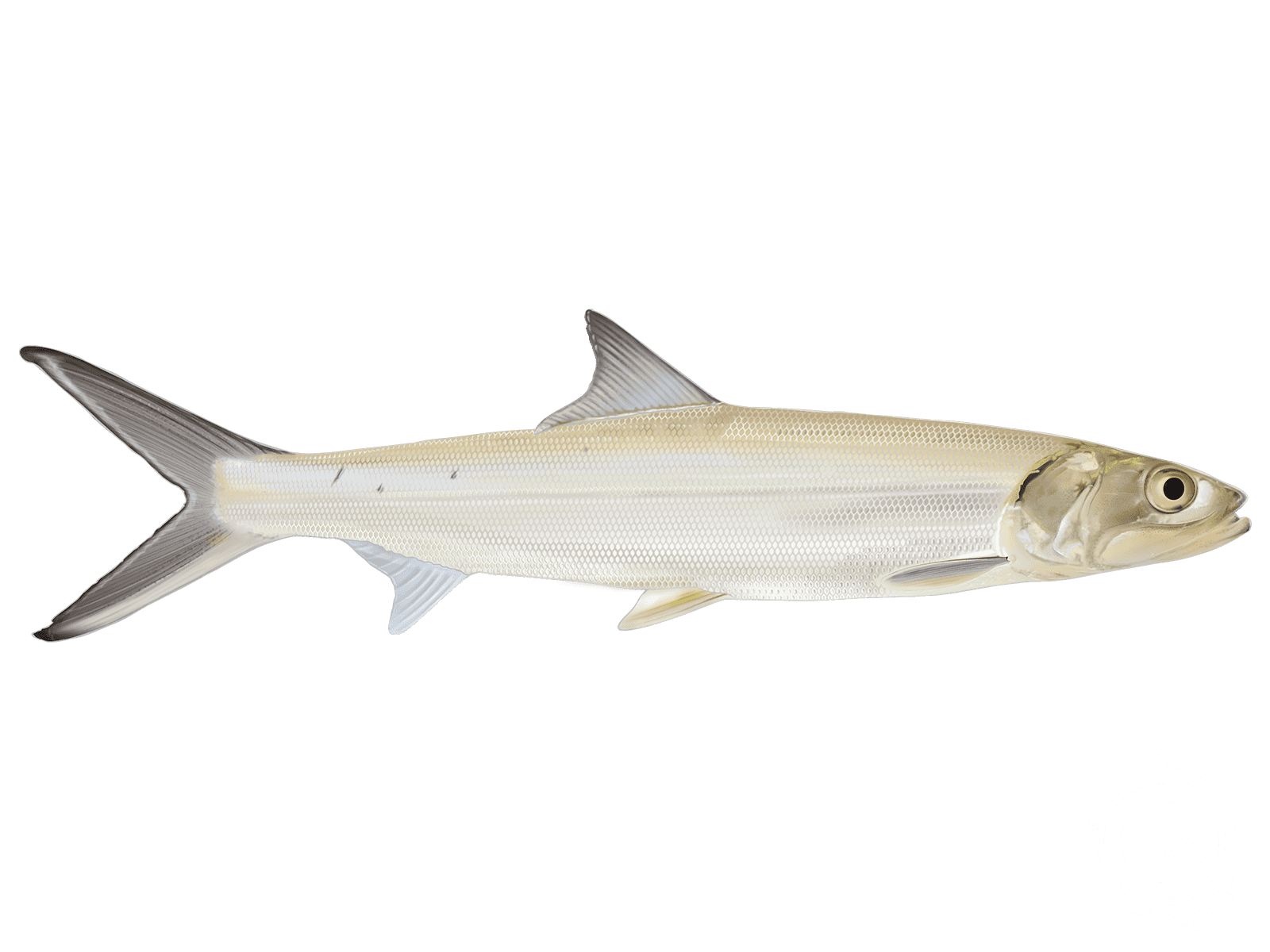Ladyfish

Species Details
Elops Saurus
Elopidae
Elopiformes
Onshore, Bay
1 - 3 lbs.
12" - 39"
What is a Ladyfish?
Ladyfish, also known as "skipjack" or "tenpounder," is a popular game fish species found in warm waters around the world. They are known for their acrobatic jumps and fast runs, making them a fun catch for recreational anglers. Ladyfish are often caught using live bait or lures and are commonly found in estuaries, bays, and shallow flats.
Ladyfish (Elops saurus) Fish Description
Also known as poor man’s tarpon, tenpounder, river fish, fiddler, silverfish, and john, the Ladyfish has a long, slender, rounded pike-like body covered with fine silvery scales. The juvenile Ladyfish appears eel-like and transparent. The Ladyfish belongs to the Elopidae family along with its cousins, the tarpon, bonefish, and skipjack.
The tail of the Ladyfish is extremely forked, while its mouth is terminal. The Ladyship is a predatory species of fish; it has a bony throat plate between its mandibles and small, sharp teeth. Though generally silvery, the Ladyfish has a bluish or greenish hue on its upper body. It has no dorsal spines, only dorsal soft rays numbering 25 to 29. It also has no anal spines but has 16 - 19 anal soft rays. Its dorsal and caudal fins are silvery or dusky yellowish; its pelvic and pectoral fins are pale and speckled. The Ladyfish have small scales, with more than 100 on the lateral line.
Ladyfish Diet and Size
The Ladyfish larvae simply absorb nutrients directly from the water. Later on, they switch to insects, small fishes, and primarily on zooplankton. As young Ladyfish, they feast on crustaceans. The adult Ladyfish are strictly carnivorous and prefer small bony fishes (including their relative's menhaden and silversides) and crustaceans.
The Ladyfish can measure up to 35 inches and weigh up to 30 pounds.
Interesting Facts About the Ladyfish
- The Ladyfish can tolerate a wide range and levels of salinity.
- It is a thermophilic (it cannot tolerate low temperatures for too long) fish; because of this, some Ladyfish numbers have been reported to have died from the cold in Florida.
- Taxonomist Carl Linnaeus himself named and classified the Ladyfish in 1766.
- They are considered by many, even anglers, as “trash fish.”
- When using cut bait to catch snook, most anglers probably prefer mullet and Ladyfish.
Ladyfish — Fishing Techniques
According to the IUCN, the Ladyfish’s status is (of) Least Concern. This fish population is plentiful. The Ladyfish is marketed as fresh but is still considered only a second-rate fish.
The Ladyfish, when hooked, is considered a good sport for light-tackle anglers. However, the Ladyfish may be annoying since they jump and skip along the water's surface after being hooked. They tend to be aggressive and usually bite the line.
Anglers can catch Ladyfish off piers, in canals, bays, and along beaches. They are inshore species that can be found in estuaries, coastal lagoons, hypersaline bays, along shorelines, and even up coastal streams. Anglers fly fishing for Ladyfish can catch them without the use of a boat. They can be caught all year round at any kind of tide and time of day. Anglers can use bait such as hair jigs, live shrimp, bubble rigs, flies, crabs, squid, and jerk baits to lure a school of Ladyfish. Since the Ladyfish usually thrash around trying to free themselves, anglers must use a heavy mono leader. Experts suggest using the fluorocarbon line as the leader; a spinning reel or spinning rod will also do. Anglers need to take caution since the Ladyfish have sharp, albeit small, teeth.
Ladyfish Habitat and Distribution
The Ladyfish is a pelagic species of fish; that live in tropical and subtropical coastal areas. They like brackish, reef-abundant areas as well as mangroves. They spawn in the open sea. The juvenile fish like low-salinity estuaries or hypersaline lagoons. Once these smaller fish mature, they move to offshore marine habitats. They live in areas as deep as 160 feet several miles offshore.
The Ladyfish can be found in the Gulf of Mexico as well as the western North Atlantic Ocean from New England to Florida. It shares a common habitat with its cousin, the malacho (Elops smithi), in the southern part of the Gulf of Mexico and the southeastern US waters. They also thrive in Bermuda, the Western Atlantic, and the south of Brazil. Some records show that they are also found in Asian countries like Vietnam, Taiwan, and China.






